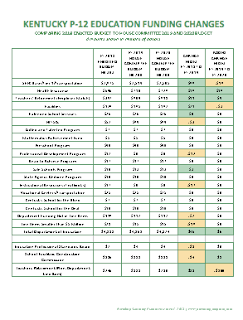| Post By Brigitte Blom Ramsey |
There is no doubt, legislators are facing difficult budget choices as the 2018 session nears its end. Proposals on the table to-date risk severely compromising our ability to ensure excellence with equity, to ensure each and every student learns at high levels, having an opportunity to realize their unique potential – regardless of their background.
Underfunded pension liabilities coupled with insufficient tax revenues have resulted in a crisis that must lead to revenue-producing tax reform critical for investments in the resource that matters most to our future growth as a state - our human capital.
Threats to equity across the pipeline of education include:
•
K-12 Basic Funding: If our main SEEK funding for education doesn’t keep up with inflation, we naturally erode the investment that goes to the classroom and that supports student learning. This erosion disproportionately impacts students from low-wealth communities and low-income households where there are fewer resources to fill the gaps, fewer educational supports, and fewer community-based learning experiences.
•
Postsecondary Institution Funding: Our disinvestment in public universities and KCTCS has resulted in cost shifting to the backs of students and families at a time when a college education is evermore important for future success. We are crowding out students who are most challenged to attend because of the cost of tuition and the wages foregone in the years when they invest their time in higher levels of education.
•
Student Supports: Students don’t learn in a vacuum. Just like adults, they bring the cares of their world with them to life in school. As adults, we know this and we’ve put community-in-school investments in place to intervene and to mitigate the effects of harsh and sometimes toxic life experiences. Over the last decade, we’ve cut important parts of that support system, and we’ve allowed inflation to weaken them even further. Weakening preschool would add to that damage. Eliminating instructional materials and making further cuts to tutoring, (ESS), reading and math grants, and other major programs would be a move in the wrong direction.
•
Teacher Supports: Dedicated programs that support teacher professional development can be exceptionally valuable to supporting teachers in under-resourced schools and in more isolated rural areas where access to the broader education community is more difficult. Cutting these programs becomes an equity issue when the teachers who are tasked with supporting the learning of students with the most challenges outside of school don’t have the tools they need to increase their own effectiveness.
•
Educator Compensation: Along all the disinvestments already discussed, proposed changes to teacher retirement will weaken teachers’ total compensation, especially if teachers aren’t provided access to the social security safety net and if we don’t recognize the need for salaries and benefits competitive with the private sector. Not recognizing these issues will make it far harder for Kentucky to attract dedicated and talented people to the teaching profession.
While legislators are debating the next biennial budget, we are not making these decisions in isolation. Other states are increasing their investment from early childhood through postsecondary, recognizing human capital as the primary economic engine of their state and education as the primary input to quality of life. If Kentucky doesn’t deepen the investment in education, we will be at a severe competitive disadvantage for economic development in the near future.
It is for all of these reasons, Kentucky must commit to tax reform that grows with the changing economy, results in sustainable and structurally balanced budgets, and fulfills the promise of public education for every Kentuckian.
As a commonwealth, it behooves us to ensure that equity is not compromised, even for a moment, and that the assurance of an excellent education for each and every young person is regarded as the single greatest investment our Commonwealth can make.































